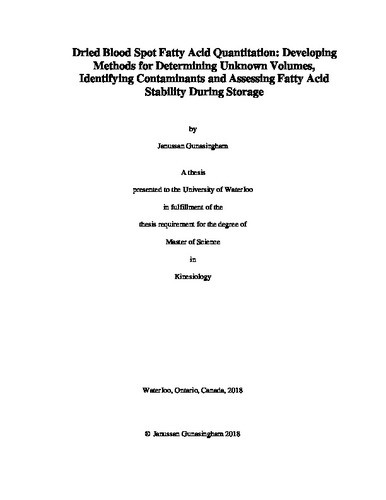| dc.contributor.author | Gunash (Gunasingham), Jan (Janussan) | |
| dc.date.accessioned | 2018-01-12 19:57:51 (GMT) | |
| dc.date.available | 2018-01-12 19:57:51 (GMT) | |
| dc.date.issued | 2018-01-12 | |
| dc.date.submitted | 2017-12-15 | |
| dc.identifier.uri | http://hdl.handle.net/10012/12858 | |
| dc.description.abstract | Omega-3 long chain polyunsaturated fatty acid (n-3 LCPUFA) blood levels are a potential risk factor for coronary heart disease, particularly sudden cardiac death. Venipuncture sampling for fatty acid profiling is invasive, requires highly qualified personnel and requires a multi-step protocol to isolate blood fractions. Alternately, the use of whole blood for fatty acid profiling improves analytical throughput and allows sample collection in field research locations by enabling dried blood spotting (DBS). Dried blood spots are advantageous in comparison to venous blood sampling as they require small blood volumes and is relatively inexpensive to collect. However, FA profiles in DBS are commonly expressed qualitatively (% of total fatty acids) and not quantitatively (µg/mL) as finger-tip prick (FTP) sampling usually results in the collection of an unknown volume of blood. Quantitation can be effected by preexisting fatty acid contaminants on DBS collection materials and oxidative losses of sensitive fatty acids such as n-3 LCPUFA due to the increased surface area of DBS samples. Fatty acid quantitation could detect hypo- and hyper-lipidemia in samples that a qualitative only assessments would miss. To address these issues, the relationship between blood volume and blood spot area on 903 Protein Saver Cards (903 PSC) was examined to determine the blood volume associated with a 6mm hole punch and the Mitra Microsampling Device, a product designed to collect 10 µL of blood regardless of hematocrit, was assessed for FA and lipidomic analyses. To determine if fatty acid contaminants were present, the 903 PSC, the Mitra tips and Whatman chromatography paper (also commonly used to collect blood spots) were examined using gas chromatography and ultra high-performance liquid chromatography coupled with tandem mass spectrometry (UHPLC-MS/MS). Finally, the stability of the fatty acids in a DBS sample on Mitra and 903 PSC stored at ambient, 4C, -20C and -80C temperatures with and without antioxidant for 3 months was examined. It was determined that the 6mm punch of 903 PSC contained 9.6 µL of blood and that FA profiles determined from the Mitra samples were comparable to FA profiles from wet blood controls. The Mitra tips could also be used to provide similar lipidomic profiles. The 903 PSC, the Mitra tips and the Whatman paper all contained palmitic and stearic acid as free fatty acids (FFA) while the Mitra tips also had palmitoyl and stearoyl lysophosphatidylcholines (LysoPC) present. With DBS storage, the n-3 LCPUFA biomarkers were the most stable with -80C storage followed by 4C or ambient room temperatures while samples stored at -20C storage had the lowest stability in both antioxidant and no antioxidant conditions, which mirrored previous research examining whole blood storage. In conclusion, quantitative fatty acid determinations of DBS samples are possible. Blood volumes can be estimated using a defined hole punch on the commonly used 903 PSC, or defined by using a Mitra sampling device. Analysis of blank sampling devices is recommended to assess the potential impact of fatty acid and fatty acyl contaminants in any DBS collection materials to be used. Finally, storage conditions need to be a consideration with DBS sample collection as preventative steps such as storage temperature and the use of antioxidants can improve sample stability and ensure data integrity. | en |
| dc.language.iso | en | en |
| dc.publisher | University of Waterloo | en |
| dc.subject | dried blood spot | en |
| dc.subject | 903 protein saver card | en |
| dc.subject | mitra microsampling device | en |
| dc.subject | quantitation | en |
| dc.subject | fatty acid | en |
| dc.subject | storage | en |
| dc.subject | contaminants | en |
| dc.subject | field application | en |
| dc.title | Dried Blood Spot Fatty Acid Quantitation: Developing Methods for Determining Unknown Volumes, Identifying Contaminants and Assessing Fatty Acid Stability During Storage | en |
| dc.type | Master Thesis | en |
| dc.pending | false | |
| uws-etd.degree.department | Kinesiology | en |
| uws-etd.degree.discipline | Kinesiology | en |
| uws-etd.degree.grantor | University of Waterloo | en |
| uws-etd.degree | Master of Science | en |
| uws.contributor.advisor | Stark, Ken | |
| uws.contributor.affiliation1 | Faculty of Applied Health Sciences | en |
| uws.published.city | Waterloo | en |
| uws.published.country | Canada | en |
| uws.published.province | Ontario | en |
| uws.typeOfResource | Text | en |
| uws.peerReviewStatus | Unreviewed | en |
| uws.scholarLevel | Graduate | en |

